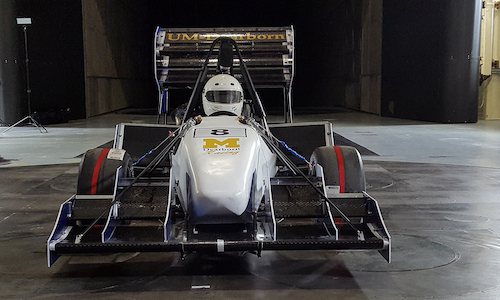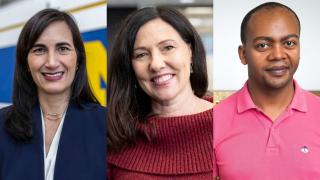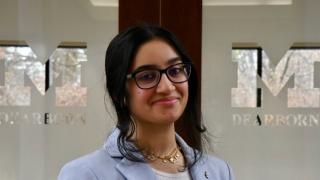UM-Dearborn’s Formula SAE team finished first in the Toronto Shootout this fall. And earlier in the year, the team placed eighth at the Formula SAE Michigan out of more than 100 teams from around the world.
“From what I’ve heard from advisers and alumni, this is the best year we’ve had,” said mechanical engineering senior Justin Rujan, a three-year Formula SAE member and president of the competitive student automotive engineering and design organization.
Rujan said there are many reasons why they’ve had a record-breaking year—strong alumni support, seasoned team members, dedicated advisers, a solid vehicle design…and a little wind power.
Ford Motor Company invited the Formula SAE team out to their Allen Park-based wind tunnel facilities, which generates a controlled stream of fast-moving air, simulating real-world conditions to allow aerodynamic development in vehicles.
The team spent nearly 10 hours at the facility, testing different wind force simulations from 20 to 60-plus miles per hour to quantify some of the computational work they’ve done.
“In a book, you can learn the basics and lay the groundwork to make design choices. But until you can actually apply that and know you’re doing it the right way, it’s hard to make those choices,” he said. “Previously, we’ve put together a car based on theory and computer simulation. Getting invited to use the wind tunnels took our design process full circle because we were able to improve and validate our design. Instead of saying we think this is what would happen, we can say with confidence what happened.”
During the testing, the team discovered a few air leaks and tweaked their design based on their findings. For example, they stabilized the wings because they shook too much with the wind force.
“Yes, we had a good design, but the wind tunnel testing made it that much better,” Rujan said. “Our results—like taking first in Toronto—speak to that.”
The Ford collaboration was introduced to the team by former UM-Dearborn Formula SAE captain Erik Stancato, (’08 B.S.E.M.E., ’12 M.S.E), now a Ford vehicle architecture-vehicle integration engineer.
“I know how important this is—to make the fastest, lightest, best Formula SAE car on the track. I’m glad that I was able to help my alma mater’s team,” Stancato said. “Ford has the testing facilities, and we can answer the technical questions and offer occasional manufacturing support.”
And Rujan said the practical advice and collaboration with Ford was a dream come true for the team.
“We got to test our car and get diagnostics on something our team built in the same place that the 2017 Ford GT Supercar was tested in,” he said. “How cool is it that?”





